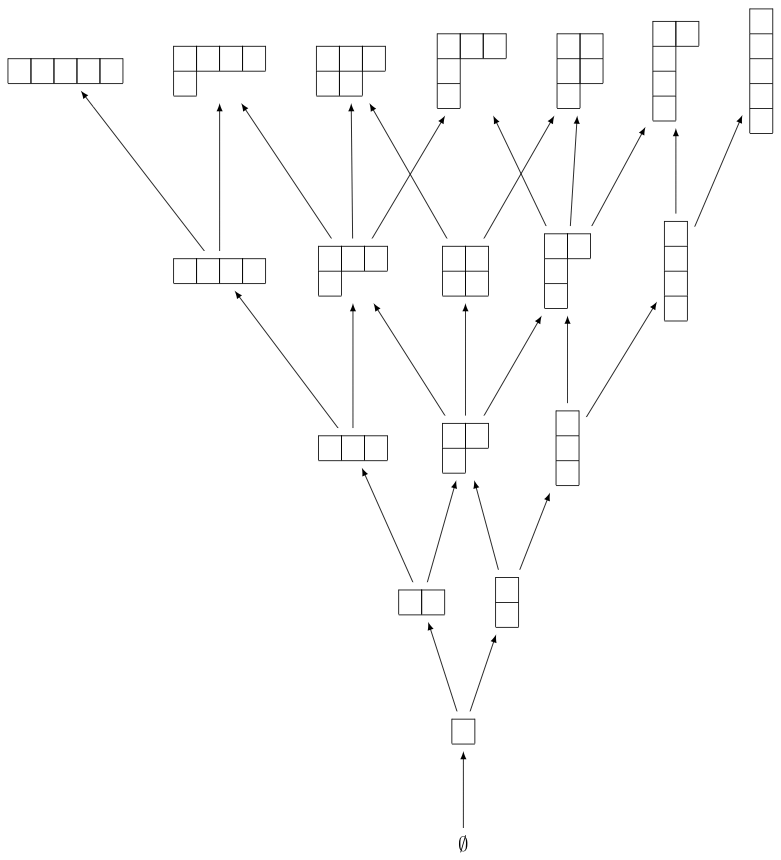Young’s lattice and the RSK algorithm¶
This section provides some examples on Young’s lattice and the RSK (Robinson-Schensted-Knuth) algorithm explained in Chapter 8 of Stanley’s book [Stanley2013].
Young’s Lattice¶
We begin by creating the first few levels of Young’s lattice \(Y\). For this, we need to define the elements and the order relation for the poset, which is containment of partitions:
sage: level = 6
sage: elements = [b for n in range(level) for b in Partitions(n)]
sage: ord = lambda x,y: y.contains(x)
sage: Y = Poset((elements,ord), facade=True)
sage: H = Y.hasse_diagram()
>>> from sage.all import *
>>> level = Integer(6)
>>> elements = [b for n in range(level) for b in Partitions(n)]
>>> ord = lambda x,y: y.contains(x)
>>> Y = Poset((elements,ord), facade=True)
>>> H = Y.hasse_diagram()
The resulting image looks best when dot2tex is installed:
sage: view(H) # not tested
>>> from sage.all import *
>>> view(H) # not tested

We can now define the up and down operators \(U\) and \(D\) on \(\QQ Y\). First we do so on partitions, which form a basis for \(\QQ Y\):
sage: QQY = CombinatorialFreeModule(QQ,elements)
sage: def U_on_basis(la):
....: covers = Y.upper_covers(la)
....: return QQY.sum_of_monomials(covers)
sage: def D_on_basis(la):
....: covers = Y.lower_covers(la)
....: return QQY.sum_of_monomials(covers)
>>> from sage.all import *
>>> QQY = CombinatorialFreeModule(QQ,elements)
>>> def U_on_basis(la):
... covers = Y.upper_covers(la)
... return QQY.sum_of_monomials(covers)
>>> def D_on_basis(la):
... covers = Y.lower_covers(la)
... return QQY.sum_of_monomials(covers)
As a shorthand, one also can write the above as:
sage: U_on_basis = QQY.sum_of_monomials * Y.upper_covers
sage: D_on_basis = QQY.sum_of_monomials * Y.lower_covers
>>> from sage.all import *
>>> U_on_basis = QQY.sum_of_monomials * Y.upper_covers
>>> D_on_basis = QQY.sum_of_monomials * Y.lower_covers
Here is the result when we apply the operators to the partition \((2,1)\):
sage: la = Partition([2,1])
sage: U_on_basis(la)
B[[2, 1, 1]] + B[[2, 2]] + B[[3, 1]]
sage: D_on_basis(la)
B[[1, 1]] + B[[2]]
>>> from sage.all import *
>>> la = Partition([Integer(2),Integer(1)])
>>> U_on_basis(la)
B[[2, 1, 1]] + B[[2, 2]] + B[[3, 1]]
>>> D_on_basis(la)
B[[1, 1]] + B[[2]]
Now we define the up and down operator on \(\QQ Y\):
sage: U = QQY.module_morphism(U_on_basis)
sage: D = QQY.module_morphism(D_on_basis)
>>> from sage.all import *
>>> U = QQY.module_morphism(U_on_basis)
>>> D = QQY.module_morphism(D_on_basis)
We can check the identity \(D_{i+1} U_i - U_{i-1} D_i = I_i\) explicitly on all partitions of \(i=3\):
sage: for p in Partitions(3):
....: b = QQY(p)
....: assert D(U(b)) - U(D(b)) == b
>>> from sage.all import *
>>> for p in Partitions(Integer(3)):
... b = QQY(p)
... assert D(U(b)) - U(D(b)) == b
We can also check that the coefficient of \(\lambda \vdash n\) in \(U^n(\emptyset)\) is equal to the number of standard Young tableaux of shape \(\lambda\):
sage: u = QQY(Partition([]))
sage: for i in range(4):
....: u = U(u)
sage: u
B[[1, 1, 1, 1]] + 3*B[[2, 1, 1]] + 2*B[[2, 2]] + 3*B[[3, 1]] + B[[4]]
>>> from sage.all import *
>>> u = QQY(Partition([]))
>>> for i in range(Integer(4)):
... u = U(u)
>>> u
B[[1, 1, 1, 1]] + 3*B[[2, 1, 1]] + 2*B[[2, 2]] + 3*B[[3, 1]] + B[[4]]
For example, the number of standard Young tableaux of shape \((2,1,1)\) is \(3\):
sage: StandardTableaux([2,1,1]).cardinality()
3
>>> from sage.all import *
>>> StandardTableaux([Integer(2),Integer(1),Integer(1)]).cardinality()
3
We can test this in general:
sage: for la in u.support():
....: assert u[la] == StandardTableaux(la).cardinality()
>>> from sage.all import *
>>> for la in u.support():
... assert u[la] == StandardTableaux(la).cardinality()
We can also check this against the hook length formula (Theorem 8.1):
sage: def hook_length_formula(p):
....: n = p.size()
....: return factorial(n) // prod(p.hook_length(*c) for c in p.cells())
sage: for la in u.support():
....: assert u[la] == hook_length_formula(la)
>>> from sage.all import *
>>> def hook_length_formula(p):
... n = p.size()
... return factorial(n) // prod(p.hook_length(*c) for c in p.cells())
>>> for la in u.support():
... assert u[la] == hook_length_formula(la)
RSK Algorithm¶
Let us now turn to the RSK algorithm. We can verify Example 8.12 as follows:
sage: p = Permutation([4,2,7,3,6,1,5])
sage: RSK(p)
[[[1, 3, 5], [2, 6], [4, 7]], [[1, 3, 5], [2, 4], [6, 7]]]
>>> from sage.all import *
>>> p = Permutation([Integer(4),Integer(2),Integer(7),Integer(3),Integer(6),Integer(1),Integer(5)])
>>> RSK(p)
[[[1, 3, 5], [2, 6], [4, 7]], [[1, 3, 5], [2, 4], [6, 7]]]
The tableaux can also be displayed as tableaux:
sage: P,Q = RSK(p)
sage: P.pp()
1 3 5
2 6
4 7
sage: Q.pp()
1 3 5
2 4
6 7
>>> from sage.all import *
>>> P,Q = RSK(p)
>>> P.pp()
1 3 5
2 6
4 7
>>> Q.pp()
1 3 5
2 4
6 7
The inverse RSK algorithm is implemented as follows:
sage: RSK_inverse(P,Q, output='permutation')
[4, 2, 7, 3, 6, 1, 5]
>>> from sage.all import *
>>> RSK_inverse(P,Q, output='permutation')
[4, 2, 7, 3, 6, 1, 5]
We can verify that the RSK algorithm is a bijection:
sage: def check_RSK(n):
....: for p in Permutations(n):
....: assert RSK_inverse(*RSK(p), output='permutation') == p
sage: for n in range(5):
....: check_RSK(n)
>>> from sage.all import *
>>> def check_RSK(n):
... for p in Permutations(n):
... assert RSK_inverse(*RSK(p), output='permutation') == p
>>> for n in range(Integer(5)):
... check_RSK(n)